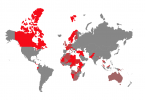In the face of the imminent climate change calamities, we have seen a dramatic rise of people who have been forced to move out of their homes – these forcefully displaced people are called environmental migrants.
International Organization of Migration (IOM) defines environmental migrants as “persons or groups of persons who, predominantly for reasons of sudden or progressive changes in the environment that adversely affect their lives or living conditions, are obliged to leave their habitual homes, or choose to do so, either temporarily or permanently, and who move within their country or abroad”.
In 2017, environmental migrants accounted for over 60 per cent of the global total according to the IDMC’s Global Report on Internal Displacement of 2018

source: http://www.internal-displacement.org/global-report/grid2018/
The general term, migration, is predominantly associated with the least developed countries (LDCs), be it armed conflict, state oppression or poverty; similarly, environmental migration affects the most vulnerable.
Environmental Justice Foundation estimated 99 per cent of the deaths from climate and weather disasters occured in LDCs, which are also only responsible for 1 per cent of global greenhouse emissions.

Photographer: Alessandro Grassani
In spite of the magnitude of this global phenomenon, environmental migration has not seen adequate policy implementation and reform on national levels.
Australia’s definition of migration, for example, does not include causes of environmental and weather destruction.
In 2018, New Zealand set out to be the first state to implement a new visa category for environmental migrants, however, the plans have since been abandoned.
Who have been affected?
Journal of Coastal Conservation has documented sea level rise average of 3mm per year globally and up to 12mm per year in the Western Pacific in recent decades.
Small low-lying islands around the world are continually being submerged, with 8 islands recorded to be swallowed by rising sea levels in 2017.
People are already relocating to larger islands as smaller ones continue to disappear.
Inhabitants on the Carteret Islands of Papua New Guinea have been migrating to Bougainville Island as it has become too risky to maintain permanent residence on many of the smaller Pacific island.
Australia already has migration legislation that focuses on the Pacific, such as the 2012 Seasonal Worker Scheme on top of its close proximity creates greater chance of future migrants seeking refuge to Australia due to climate change.





